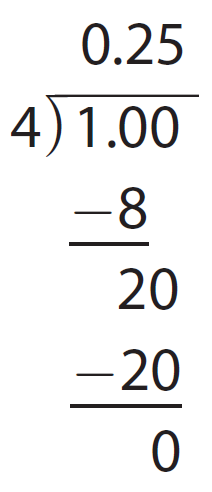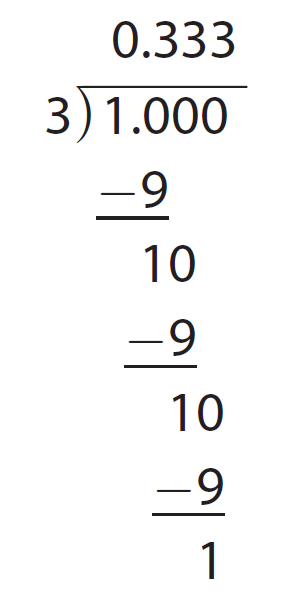EXPRESSING RATIONAL NUMBERS AS DECIMALS WORKSHEET
Problem 1 :
Write the fraction 1/4 as a decimal.
Problem 2 :
Write the fraction 1/3 as a decimal.
Problem 3 :
Write 96/200 as a decimal.
Problem 4 :
Write 2/5 as a decimal.
Problem 5 :
Write 48/5 as a decimal.
Problem 6 :
Write 1/8 as a decimal.

Detailed Answer Key
Problem 1 :
Write the fraction 1/4 as a decimal.
Solution :

So, the decimal equal to the fraction 1/4 is 0.25
Problem 2 :
Write the fraction 1/3 as a decimal.
Solution :

So, the decimal equal to the fraction 1/3 is 0.333......
or

Problem 3 :
Write 96/200 as a decimal.
Solution :
Step 1 :
In the fraction 96/200, the denominator 200 is a multiple of 100.
So we can change the denominator 200 as 100 by dividing both numerator and denominator by 2.
96/200 = (96÷2) / (200÷2) = 48/100
Step 2 :
In 48/100, since the denominator is 100, 48/100 can be easily converted to decimal.
In the numerator 48, there is no decimal point. Let us assume there is a decimal at the end of 48, that is (48.)
Because we divide 48 by 100 and there are two zeros in 100, we have to move the decimal point in (48.) two digits to the left.
So, we have
48/100 = 0.48
Therefore, the decimal equal to the fraction 96/200 is 0.48
Problem 4 :
Write 2/5 as a decimal.
Solution :
Step 1 :
In the fraction 2/5, the denominator 5 is a factor of 10. So we can change the denominator 5 as 10 by multiplying both numerator and denominator by 2.
2/5 = (2x2) / (5x2) = 4/10
Step 2 :
In 4/10, since the denominator is 10, 4/10 can be easily converted to decimal.
In the numerator 4, there is no decimal point. Let us assume there is a decimal point after 4, that is (4.).
Because we divide 4 by 10 and there is only one zero in 10, we have to move the decimal point in (4.) one digit to the left.
So, we have
4/10 = 0.4
Therefore, the decimal equal to the fraction 2/5 is 0.4
Problem 5 :
Write 48/5 as a decimal.
Solution :
Step 1 :
In the fraction 48/5, the denominator 5 is a factor of 10. So we can change the denominator 5 as 10 by multiplying both numerator and denominator by 2.
48/5 = (48x2) / (5x2) = 96/10
Step 2 :
In 96/10, since the denominator is 10, 96/10 can be easily converted to decimal.
In the numerator 96, there is no decimal point. Let us assume there is a decimal point after 96, that is (96.).
Because we divide 96 by 10 and there is only one zero in 10, we have to move the decimal point in (96.) one digit to the left.
So, we have
96/10 = 9.6
Therefore, the decimal equal to the fraction 48/5 is 9.6
Problem 6 :
Write 1/8 as a decimal.
Solution :
In the fraction 1/8, the denominator 8 is not a factor or multiple of 10 or 100.
And also, we can not change the denominator 8 as a multiple of 10 or 100.
Use long division to divide the numerator by the denominator.

So, the decimal equal to the fraction 1/8 is 0.125
Kindly mail your feedback to v4formath@gmail.com
We always appreciate your feedback.
©All rights reserved. onlinemath4all.com
Recent Articles
-
AP Calculus AB Problems with Solutions (Part - 8)
Jan 30, 25 09:48 AM
AP Calculus AB Problems with Solutions (Part - 8) -
SAT Math Resources (Videos, Concepts, Worksheets and More)
Jan 29, 25 06:00 AM
SAT Math Resources (Videos, Concepts, Worksheets and More) -
Digital SAT Math Problems and Solutions (Part - 105)
Jan 29, 25 05:52 AM
Digital SAT Math Problems and Solutions (Part - 105)
